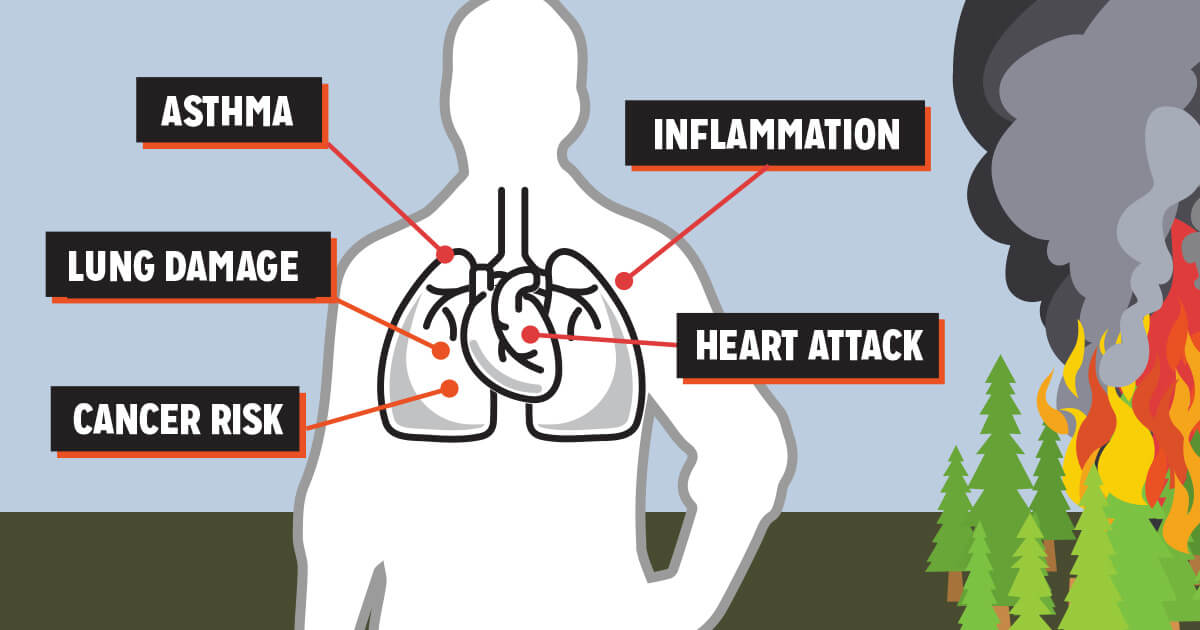In recent years, wildfires have intensified in both frequency and severity, particularly along the East Coast and other parts of the U.S. While the immediate threat of flames is obvious, the lingering smoke in the atmosphere poses a far more insidious danger—one that affects millions, especially vulnerable groups. Wildfire smoke is packed with harmful pollutants that can deeply compromise lung health and overall well-being.
This guide offers a detailed look into how wildfire smoke affects the respiratory system, the health risks involved, and what precautions you can take to minimize exposure.

What’s in Wildfire Smoke?
Wildfire smoke is not just regular smoke—it is a toxic cocktail of hazardous substances including:
-
Fine Particulate Matter (PM2.5): These microscopic particles are smaller than 2.5 microns and can penetrate deep into the lungs and even enter the bloodstream.
-
Carbon Monoxide (CO): A harmful gas that can reduce oxygen levels in the body.
-
Volatile Organic Compounds (VOCs): Chemicals that can cause short-term and long-term health effects.
-
Polycyclic Aromatic Hydrocarbons (PAHs): Organic compounds linked to cancer and respiratory issues.
Immediate Effects of Exposure to Wildfire Smoke
Irritation of Eyes, Nose, and Throat
One of the first signs of smoke exposure includes burning eyes, runny nose, and a sore throat. These symptoms are the body’s response to irritants in the air.
Exacerbation of Asthma and COPD
People with existing respiratory conditions like asthma and chronic obstructive pulmonary disease (COPD) are particularly vulnerable. Smoke inhalation can:
-
Trigger asthma attacks
-
Increase breathlessness
-
Heighten the need for inhalers or steroids
Increased Risk of Respiratory Infections
Inhaling particulate matter can weaken lung immunity, making it easier for bacteria and viruses to invade. This leads to a higher risk of:
-
Bronchitis
-
Pneumonia
-
Other lower respiratory tract infections
Long-Term Health Impacts of Prolonged Exposure
Reduced Lung Function in Children
Children breathe more air per pound of body weight compared to adults, and their lungs are still developing. This makes them extremely susceptible to:
-
Decreased lung growth
-
Reduced respiratory capacity later in life
Chronic Respiratory Diseases
Continued exposure to wildfire smoke can lead to:
-
Chronic bronchitis
-
Asthma onset in adults
-
Persistent cough and wheezing
Cardiovascular Complications
PM2.5 particles don’t just stay in the lungs—they can enter the bloodstream, causing:
-
Systemic inflammation
-
Increased risk of stroke
-
Heart attacks
-
Worsening of existing heart conditions
Who is Most at Risk?
According to Dr. Syed Nazeer Mahmood, a Pulmonary/Critical Care specialist at Bayhealth, the following groups are especially susceptible:
-
People with pre-existing lung or heart conditions
-
Children
-
Elderly adults
-
Pregnant women
“Children are particularly vulnerable because their lungs are still developing, and they breathe more air per unit of body weight than adults,” says Dr. Mahmood.
How to Protect Yourself from Wildfire Smoke
Monitor Air Quality Daily
Use air quality apps or websites like AirNow.gov to track AQI (Air Quality Index). Avoid outdoor activities when levels are above 100.
Stay Indoors on High-Smoke Days
-
Keep windows and doors closed
-
Use HEPA air purifiers to clean indoor air
-
Seal any air leaks in your home
Use the Right Mask
When going outside during smoky conditions, wear a N95 respirator. These masks filter out at least 95% of airborne particles, including PM2.5.
Maintain Indoor Air Quality
-
Use central air systems with high-efficiency filters
-
Avoid indoor activities that worsen air (like burning candles or frying food)
Preparing for the Future: Long-Term Solutions
As climate change fuels more wildfires, it’s essential to be proactive:
-
Advocate for clean energy policies to reduce climate change
-
Encourage reforestation and controlled burns to reduce fuel for wildfires
-
Support community alert systems and emergency preparedness plans
Frequently Asked Questions:
Q1. What is PM2.5 and why is it dangerous?
A: PM2.5 refers to fine particles less than 2.5 microns in diameter. They are harmful because they penetrate deep into the lungs and can enter the bloodstream, causing respiratory and cardiovascular issues.
Q2. How can I check the air quality in my area?
A: You can use platforms like AirNow.gov or apps like IQAir to monitor real-time AQI and determine whether it’s safe to be outdoors.
Q3. Are children more affected by wildfire smoke?
A: Yes, children are more affected because they have developing lungs and breathe more air relative to their body size.
Q4. Can wearing a cloth mask protect me from wildfire smoke?
A: No. Only N95 or equivalent respirators are effective against PM2.5 particles. Cloth masks do not provide adequate filtration.
Q5. Is it safe to exercise outside during smoky days?
A: Absolutely not. Physical activity increases your breathing rate and exposure to pollutants. Exercise indoors when air quality is poor.




